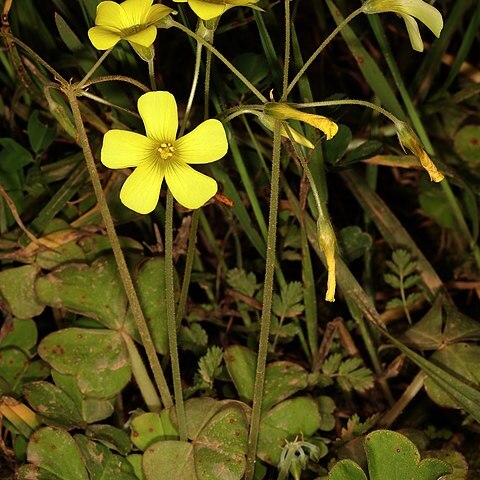Perennial herb without stems; bulb ovoid, 0.8–1.5 (–3) cm long, pointed, tunics pale brown; bulbils formed on white fleshy rhizome and in lower leaf axils. Indumentum of simple eglandular and glandular hairs. Stipules membranous, narrow, to c. 10 mm long, abruptly tapering into petiole. Leaves crowded, trifoliolate; petiole 1.2–20 cm long, dorso-ventrally compressed and narrowly winged, sparsely to moderately hairy on margins only or on the whole petiole, the hairs usually patent or sometimes mixed with underlying appressed or ascending simple antrorse hairs; leaflets subsessile, cuneate-obcordate, 10–30 mm long, 15–35 mm wide, bilobed (sinus to c. one-quarter leaflet length), green, glabrous above, sparsely pubescent below, margins ciliate, lobes oblong, divergent, apices rounded, 10–35 mm apart. Inflorescences basal, (1–) 3–6 (–10)-flowered; peduncles longer than leaves, 10–20 (–31) cm long, indumentum similar to petioles, but less hairy; pedicels often 20 mm long, covered with a mixture of antrorse simple hairs and spreading glandular hairs. Bracts situated at base of pedicels, linear-lanceolate, 4–6.5 mm long, with orange calli near apex. Sepals lanceolate, 5–7 mm long, green at base, reddish at apex, indumentum similar to pedicels, usually with 2 orange apical calli. Petals broadly cuneate, 15–20 mm long, yellow, with scattered appressed, antrorse hairs on the outer surface. Stamens at 2 levels; filaments glandular pilose with broad teeth. Ovary pubescent on upper half. Styles with appressed-ascending, antrorse hairs. Capsules not developed in Australia.
More
Like O. pes-caprae but petioles flattened, leaflets sometimes purplish below, and peduncles 3-6-flowered. Flowers yellow, rarely cream with yellow centre, petals sometimes purple-margined below.
Like O. pes-caprae but petioles flattened and peduncles 3-6-flowered. Flowers yellow.
A herb with a bulb. It keeps growing from year to year. The flowers are yellow.
In Western Australia, Oxalis compressa is known only from farmland at Toodyay (Hussey et al. 1997). In South Australia, it grows in disturbed sites such as roadsides, but has also been collected from indigenous or semi-indigenous vegetation such as at Marino Conservation Park, where it was noted as growing with Acacia ligulata and A. victoriae, and indigenous and introduced Poaceae (Robertson 617, n.v.). In Victoria, currently confined to degraded sites in grassland dominated by introduced species at Broadmeadows Valley Park, where it is very common, and at the grounds of the Arthur Rylah Institute, Heidelberg.
More
It grows in warm temperate places.

